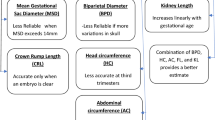Abstract
In this paper, the segmentation and extraction of features from ultrasound second trimester fetal images have been presented for early detection of Down syndrome. The region of interest and the edges of the segmented region have been obtained using mean shift analysis and Canny operator, respectively. The prime features such as the nasal bone, the palate and the frontal bone have been segmented for estimating the nasal bone length and frontomaxillary facial angle (FMF). It is observed from the results that the rate of growth of nasal bone length is poor and the FMF angle has been found to increase above 85° for fetus with trisomy 21. This analysis may help the physician for better clinical diagnosis.
Similar content being viewed by others
References
Nicolaides K.H., Azar G., Byrne D., Mansur C., Marks K.: Fetal nuchal translucency: ultrasound screening for chromosomal defects in first trimester of pregnancy. BMJ 304, 867–889 (1992)
Nicolaides K.H.: Nuchal translucency and other first-trimester sonographic markers of chromosomal abnormalities. Am. J. Obstet. Gynecol. 191, 45–67 (2004)
Khalil A., Pandya P.: Screening for Down syndrome. J. Obstet. Gynaecol. India 56(3), 205–211 (2006)
Bromley B., Lieberman E., Shipp T.D., Benacerraf B.R.: Fetal nasal bone length: a marker for Down syndrome in the second trimester. J. Ultrasound Med. 21, 1387–1394 (2002)
Bromley B., Lieberman E., Shipp T.D., Benacerraf B.R.: Fetal nose bone length. J. Ultrasound Med. 21, 1387–1394 (2002)
Cicero S., Bindra R., Rembouskos G., Tripsanas C., Nicolaides K.H.: Fetal nasal bone length in chromosomally normal and abnormal fetuses at 11-14 weeks of gestation. J. Matern. Fetal. Neonatal. Med. 11, 400–402 (2002)
Bekker M.N., Twisk J.W.R., van vugt J.M.G.: Reproducibility of the fetal nasal bone length measurement. J. Ultrasound Med. 23, 1613–1618 (2004)
Sieroszewski P., Perenc M., Bas-BudeckaE. Suzin J.: Ultrasound diagnostic schema for determination of increased risk for chromosomal fetal aneuploidies in the first half of pregnancy. J. Appl. Genet. 47(2), 177–185 (2006)
Sonek J.D., Cicero S., Neiger R.: Nasal bone assessment in prenatal screening for trisomy 21. Am. J. Obstet. Gynecol. 195, 1219–1230 (2006)
Canda MT, Demir N.: Contemporary screening in pregnancy. J. Turkish-German Gynecol. Assoc. 8(3), 331–338 (2007)
Cicero S., Sonek J.D., Mc Kenna D.S.: Nasal bone hypoplasia in Trisomy 21 at 15–22 weeks gestation. Ultrasound Obstet. Gynecol. 21, 15–18 (2003)
Viora, E., Errante, G., Sciarrone, A.: Fetal nasal bone and trisomy 21 in the second trimester, Ultrasound and prenatal diagnosis unit, Wiley
Jiri Sonek, M.D., Marisa Borenstein, M.D.: Fronto maxillary facial angle in screening for Trisomy 21 at 14–23 weeks gestation. Am. J. Obstet. Gynecol. 197, 167.e1–167.e5 (2007)
Sonek J., Borenstein M.: Fronto maxillary facial angle in fetuses with trisomy 21 at 11–13 weeks. Am. J. Obstet. Gynecol. 196(3), 271.e1-4 (2007)
Molina F., Persico N.: Fronto maxillary facial angle in screening for trisomy 21 at 16–24 weeks gestation. Ultrasound Obstet. Gynecol. 31(4), 384–387 (2008)
Borenstein M., Persico N.: Fronto maxillary facial angle in screening for trisomy 21 at 11–13 weeks. Ultrasound Obstet. Gynecol. 32(1), 5–11 (2008)
Edund Hui, Ng.: Speckle noise reduction via homomorphic elliptical threshold rotations in complex wavelet domain, A MS Thesis Presented to University of Waterloo, Canada, (2005)
Thakura A., Anand R.S.: Speckle reduction in ultrasound medical images using adaptive filter based on second order statistics. J. Med. Eng. Technol. 31(4), 263–279 (2007)
Thangavel, K., Manavalan, R., Aroquiaraj, I.L.: Removal of speckle noise from ultrasound medical image based on special filters: comparative study. ICGST-GVIP J. 9(III) (2009). ISSN 1687-398X
Sanches J.M., Nascimento J.C, Marques J.S.: Medical image noise reduction using the Sylvester-Lyapnov equation. IEEE Trans. Image Process. 17(9), 1522–1539 (2008)
Rajabi, M.A., Mansurpour, M.: Effects and performance of speckle noise reduction filters on active radar and sar images. Workshop on ISPRS, Ankara, Turkey ISPRS Volume Number:XXXVI-I/W41, Feb (2006)
Fashing M., Tomasi C.: Mean shift is a bound optimization. IEEE Trans. Pattern Anal. Mach. Intell. 27(3), 471–474 (2005)
Rodriguez R., Catillo P.J., Guerra V., Suarez A.G., Izquierdo E.: Two robust techniques for segmentation of biomedical images. Comput. y Syst. 9(4), 355–369 (2006)
Comaniciu, D., Meer, P.: Mean shift analysis and applications, Research article, Rutgers University, Piscataway, NJ
Chen, T.-H., Lin, Y.-F., Chen, T.-Y.: Intelligent vehicle counting method based on blob analysis in traffic surveillance. In: Second International Conference on Innovative Computing, Information and Control, 2007. ICICIC apos;07, Issue 5–7, pp. 238–238. Sept (2007)
Neatpisarnvanit, C., Suthakorn, J.: Intramedullary nail distal hole axis estimation using blob analysis and Hough transform, robotics, automation and mechatronics, 2006. In: IEEE Conference on, 1–3 June, pp. 1–6 (2006)
Author information
Authors and Affiliations
Corresponding author
Rights and permissions
About this article
Cite this article
Nirmala, S., Palanisamy, V. Clinical decision support system for early prediction of Down syndrome fetus using sonogram images. SIViP 5, 245–255 (2011). https://doi.org/10.1007/s11760-010-0158-8
Received:
Revised:
Accepted:
Published:
Issue Date:
DOI: https://doi.org/10.1007/s11760-010-0158-8




